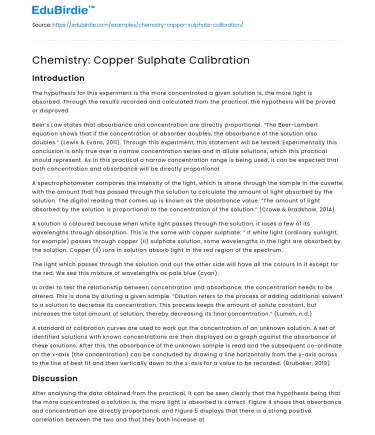Introduction
The hypothesis for this experiment is the more concentrated a given solution is, the more light is absorbed. Through the results recorded and calculated from the practical, the hypothesis will be proved or disproved.
Beer’s Law states that absorbance and concentration are directly proportional. “The Beer-Lambert equation shows that if the concentration of absorber doubles, the absorbance of the solution also doubles.” (Lewis & Evans, 2011). Through this experiment, this statement will be tested. Experimentally this conclusion is only true over a narrow concentration series and in dilute solutions, which this practical should represent. As in this practical a narrow concentration range is being used, it can be expected that both concentration and absorbance will be directly proportional.
Save your time!
We can take care of your essay
- Proper editing and formatting
- Free revision, title page, and bibliography
- Flexible prices and money-back guarantee
A spectrophotometer compares the intensity of the light, which is shone through the sample in the cuvette, with the amount that has passed through the solution to calculate the amount of light absorbed by the solution. The digital reading that comes up is known as the absorbance value. “The amount of light absorbed by the solution is proportional to the concentration of the solution.” (Crowe & Bradshaw, 2014)
A solution is coloured because when white light passes through the solution, it loses a few of its wavelengths through absorption. This is the same with copper sulphate: ” If white light (ordinary sunlight, for example) passes through copper (II) sulphate solution, some wavelengths in the light are absorbed by the solution. Copper (II) ions in solution absorb light in the red region of the spectrum.
The light which passes through the solution and out the other side will have all the colours in it except for the red. We see this mixture of wavelengths as pale blue (cyan).
In order to test the relationship between concentration and absorbance, the concentration needs to be altered. This is done by diluting a given sample. “Dilution refers to the process of adding additional solvent to a solution to decrease its concentration. This process keeps the amount of solute constant, but increases the total amount of solution, thereby decreasing its final concentration.” (Lumen, n.d.)
A standard or calibration curves are used to work out the concentration of an unknown solution. A set of identified solutions with known concentrations are then displayed on a graph against the absorbance of these solutions. After this, the absorbance of the unknown sample is read and the subsequent co-ordinate on the x-axis (the concentration) can be concluded by drawing a line horizontally from the y-axis across to the line of best fit and then vertically down to the x-axis for a value to be recorded. (Brubaker, 2019)
Discussion
After analysing the data obtained from the practical, it can be seen clearly that the hypothesis being that the more concentrated a solution is, the more light is absorbed is correct. Figure 4 shows that absorbance and concentration are directly proportional, and Figure 5 displays that there is a strong positive correlation between the two and that they both increase at similar rates. As discussed and explained in the introduction, Beer’s law states that both absorbance and concentration are directly proportional, which the results from the experiment support.
The only potential experimental errors from this practical could be using the correct volumes and making sure to use clean disposable tip each time when changing between the two solutions. A Gilson pipette was used, so this increased accuracy in volume amounts, reducing the risk of error.
Titrations are another way to measure the concentration of a given sample: “Titrations use chemical reactions to help us to measure directly how much of a compound is present in a sample… We can use the known stoichiometry of a chemical reaction to deduce the concentration of another compound with which it interacts (or reacts)”.
When titration is carried out, the volume of a known concentration can be measured and then added to a solution of an unknown concentration to trigger a change in colour. The volume of reagent added can then be used to work out the concentration of the test solution. This is done by using the following equation:
This can then be algebraically rearranged to give the value of the unknown concentration.
However, there are some advantages and disadvantages to this method. Firstly, it’s an easy practical which does not require a high level of skill and has the ability to accurately measure. Then again, this method does have some drawbacks such as there’s a large room for human error and has limited accuracy. Also, it requires relatively large quantities of the substance being analysed and produces significant amounts of chemical waste. (Crowe & Bradshaw, 2014).
Conclusions
After this experiment, it can be concluded that Beer’s law is correct. The results from this practical align with the statement of Beer’s law that the concentration of a substance and its absorption of light are directly proportional. In Figure 4, it shows how both absorbance and concentration support this. Furthermore, the data also proves the hypothesis from the start of the experiment to be correct as you can see in Figure 5 that the data has a strong positive correlation. This shows that the more concentrated a solution is, the more light is absorbed.






 Stuck on your essay?
Stuck on your essay?

